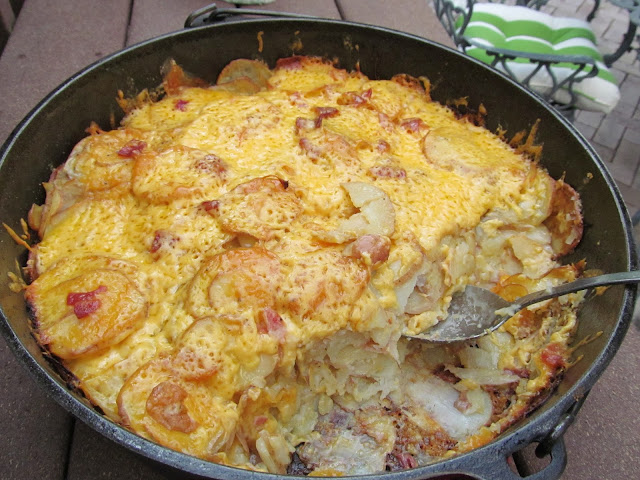Potatoes, bacon, onions, cheese, chicken broth, and salt and pepper. That's it! These are always a crowd pleaser. You can cook them inside in your oven or outside with a few pieces of hot charcoal. See step by step instructions below.
Dutch Oven Potatoes
 Slice the potatoes as uniformly as possible. If you have a food processor, it saves lots of time. I like to use red potatoes so I don't have to peel them.
Slice the potatoes as uniformly as possible. If you have a food processor, it saves lots of time. I like to use red potatoes so I don't have to peel them.
I use whatever bacon is on sale, but if it's not very lean, I discard most of the fat, as it goes in raw and I don't want extra bacon fat in my potatoes. Cut it into small pieces. I use a pound of bacon for a large pot of potatoes.
Using vegetable oil or shortening, wipe down the whole pot, including the sides and inside of the lid. Start layering the ingredients in the pot. The first layer should be a few pieces of the bacon.
Next, a layer of onions. . .
Then some potatoes. . .
Every time you do a layer of potatoes, salt and pepper well. I like to use coarse grind pepper. Now do a layer of cheese. If you have more cheese than you'll be using in the potatoes, don't reach your hands into the bowl after you have touched the bacon, or you will contaminate the cheese for later use. It's best to plan to use it all if you touch it with your hand that has touched raw bacon, and the same with the onions and potato.
Now do the whole process over again. Bacon next . . .
Onions again . . . I know, you are probably saying, "Okay, okay, I get it already"-- but I want to show all my pictures! More potatoes, salt and pepper, and cheese again. We're almost to the top, so throw in the rest of the bacon, and any extra onions. Remember to salt and pepper generously over each layer--it takes more than you might think, and you don't want them to be tasteless.























































